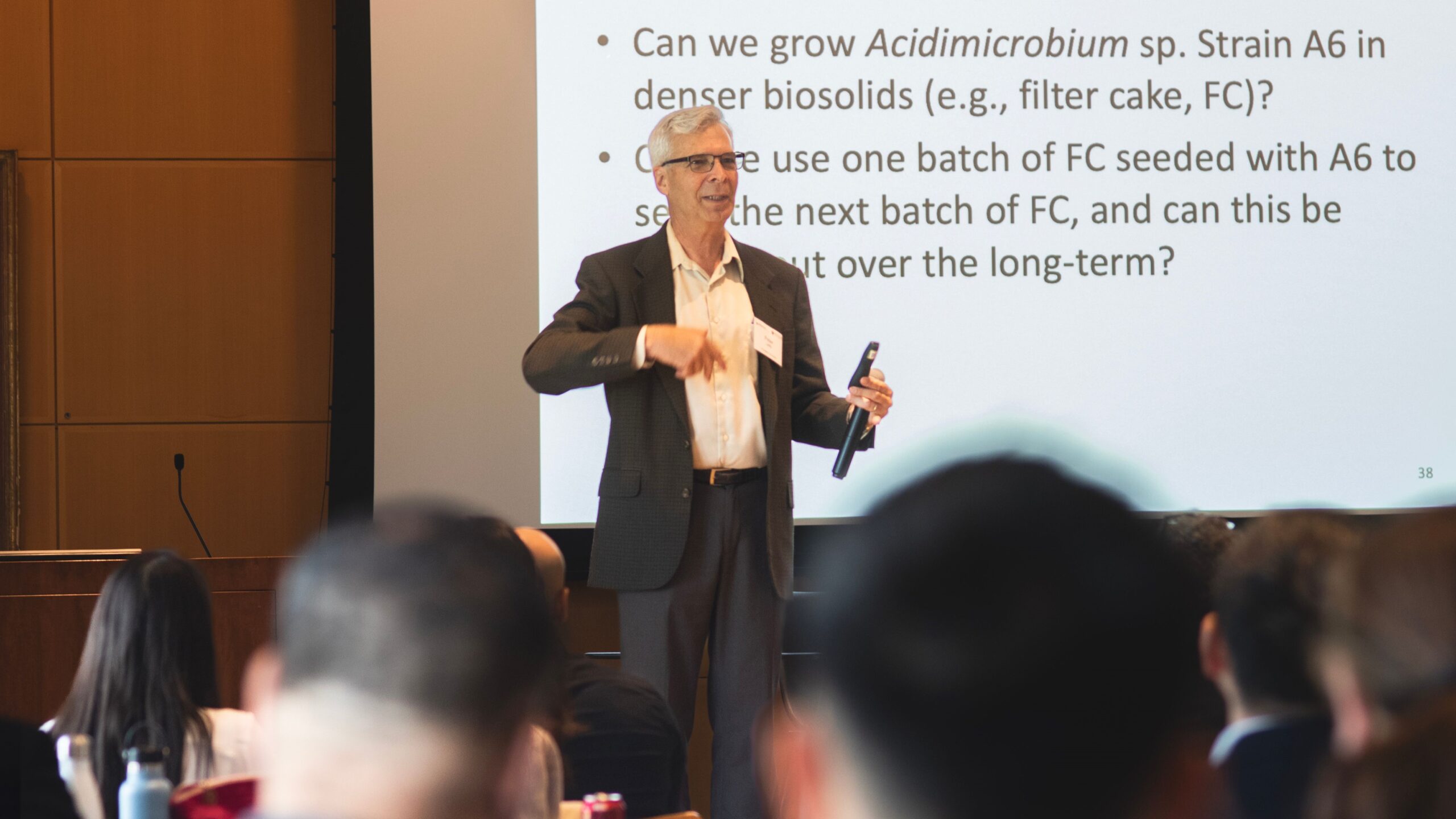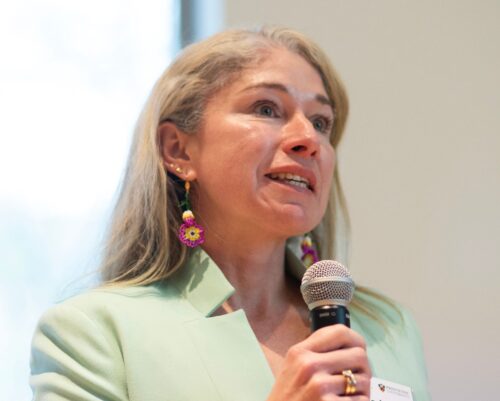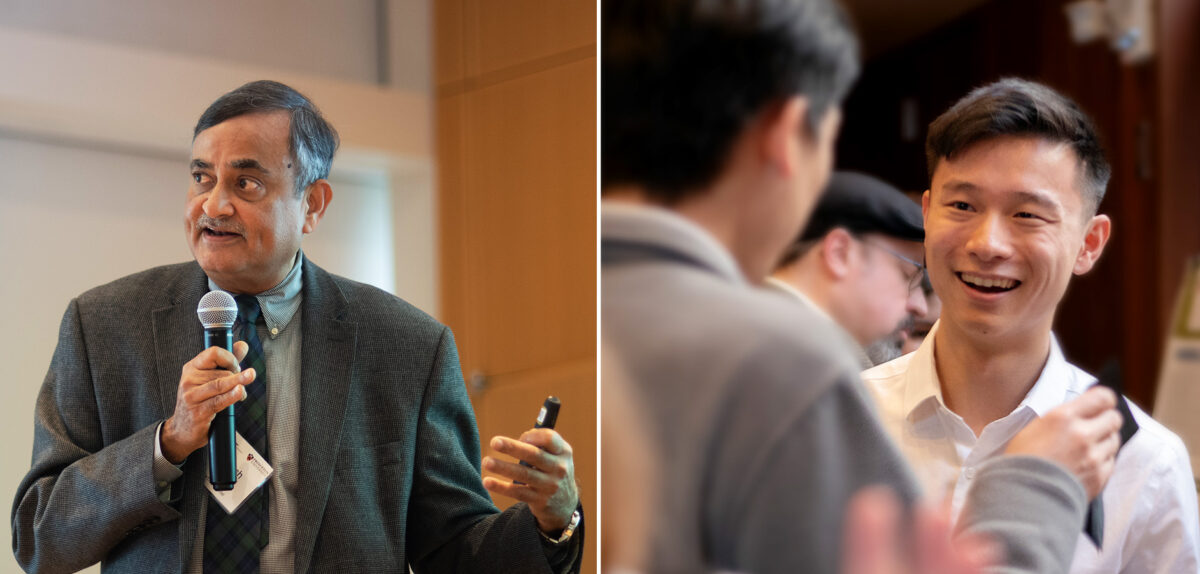Experts from across sectors convene to discuss PFAS solutions at Andlinger Center summit

Over 80 leaders from academia, industry, and the public sector gathered on Princeton’s campus in April to brainstorm impactful solutions for combating PFAS contamination.
PFAS (poly- and perfluoryl alkyl substances) are a group of over 12,000 long-lasting compounds commonly found in products such as non-stick cookware, water-resistant fabrics, and firefighting foams. Long-term exposure to PFAS, sometimes called ‘forever chemicals’ for their ability to persist for extended periods in the environment, has been linked to cancer and other illnesses in humans and poses a significant public health hazard.
The summit emphasized the issue of PFAS in biosolids — the solid organic matter recovered from the wastewater treatment process. These biosolids are nutrient-rich and are often applied to agricultural lands, yet much of the PFAS entering a wastewater treatment plant tends to accumulate in them, potentially allowing the contaminants to enter the food chain.

“Our goal is not just to better understand the scale of the problem but to spearhead the development of effective strategies for mitigating the negative impacts of PFAS,” said Angela Fasnacht, the Gerhard R. Andlinger Visiting Fellow who led the event, in her opening remarks. “We are here today to share insights with one another and form long-lasting partnerships on the road to solving the problem of PFAS pollution, a challenge that requires innovation, collaboration, and dedicated funding.”
The summit took place just two days after the U.S. Environmental Protection Agency announced a national drinking water standard related to PFAS contamination. The standard sets maximum concentration levels for six PFAS, requiring public water systems to monitor and take action to ensure contaminant levels are below the established thresholds.
While the new standard is a major advancement for regulating PFAS compounds in drinking water systems, no standards have been established yet for managing PFAS in biosolids.
During a morning panel discussion between state and federal regulators, speakers mentioned that studies are already underway to better understand the amount and sources of PFAS flowing into wastewater treatment facilities across the country. However, as it stands, much less is understood about the prevalence and life cycle of PFAS in biosolids when compared to drinking water systems.
Even given present uncertainties, speakers from across all panels were optimistic that solutions for managing PFAS in a wide range of applications were both possible and forthcoming. To promote open expression of ideas, the day’s discussions were held under Chatham House Rules, in which content could be quoted without identifying individual speakers.
“I refuse to let my team use the term ‘forever chemicals.’ That’s admitting defeat,” said one of the day’s 25 speakers. “I think it’s important to communicate that PFAS are not always going to stay as forever chemicals. We will take care of them.”
One ongoing challenge is that most currently available technologies for dealing with PFAS contamination center on the capture, concentration, and removal of PFAS from water systems, but there are fewer and usually costlier options for breaking down the contaminants into more benign compounds. Consequently, some panelists expressed concern that strategies for dealing with PFAS might remove the contaminants from one system but create a new hazard wherever they are stored.
During a keynote presentation, however, Peter Jaffé, the William L. Knapp ’47 Professor of Civil Engineering, described ongoing efforts in his research group to develop a new microbial approach for degrading PFAS contaminants. Originally found in soil samples taken from the Assunpink wetland outside of Trenton, the bacteria have an innate ability to degrade PFAS compounds that, if refined and scaled, could one day become a solution for remediating contaminated environments by breaking PFAS into safer compounds.
“When I was a graduate student many years ago, we were in a very similar place with organic chlorinated compounds as we are right now with PFAS,” said Jaffé, who has delivered expert testimony to Congress on the topic of PFAS pollution. “It’s true that we are still at the beginning in terms of the development of technologies for PFAS biodegradation. It will take time, but if we act quickly and together, we will get there.”
A panel moderated by Rengarajan Ramesh, operating partner at EagleTree Capital and a visiting research collaborator in the Department of Civil and Environmental Engineering, highlighted other technologies potentially capable of destroying or degrading PFAS. Some of the technologies included the use of cold and warm plasmas, electrochemistry, and supercritical water oxidation to destroy PFAS from landfills, biosolids, and water systems. However, the panelists agreed that considerable challenges remain in making these technologies affordable and widely available. To encourage further technological development and deployment, Ramesh suggested that regulations should be structured to drive the destruction and elimination of PFAS, rather than merely capturing and containing the contaminants.
“There is likely no silver bullet — no one technology — that will solve every one of our problems. Instead, the idea of today is to gain exposure to the various technologies that are being worked on and then understand how you can leverage them to come up with a solution that is specific to your needs,” said Ramesh. “This is truly a PFAS solutions summit.”

After the panel discussions, experts participated in a set of breakout sessions, in which participants outlined a roadmap to address outstanding questions about PFAS contamination and remediation.
One session explored management solutions for land contaminated by PFAS through biosolids. Experts identified near-term research priorities, such as a better understanding of how PFAS is absorbed into soils and subsequent implications for crop selection and growth.
Another session tackled the challenge of how to transfer PFAS removal and destruction technologies to small or decentralized community water systems, emphasizing the importance of proactive engagement with community members to design community-specific solutions.
Other sessions touched on the development and scale-up of PFAS destruction technology, the efficacy and optimization of existing PFAS removal technologies, and the regulatory challenges of managing the contaminants, which do not fit neatly into existing categories.
Following the breakout sessions, the group reconvened to share their insights and come together to identify the most urgent research, policy, and technological solutions for addressing PFAS.
“We started this morning with the idea that we need to bring some of the brightest minds together to figure out the ways to move forward — identifying the research needs, the policy gaps, and the necessary partnerships for truly making a difference with PFAS,” Fasnacht said in her closing remarks. “I’m confident that the conversations we’ve had won’t end with today. Really, they’re just the beginning of collaborations that will lead us toward actionable solutions.”
Angela Fasnacht is currently a Gerhard R. Andlinger Visiting Fellow in Energy and the Environment. The Gerhard R. Andlinger Visiting Fellows program is designed to attract distinguished visitors to collaborate with faculty, researchers, and students, and enrich the research programs and teaching at the Andlinger Center.